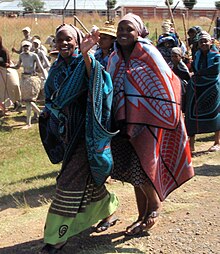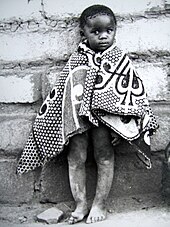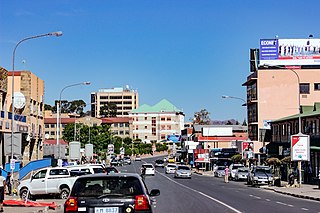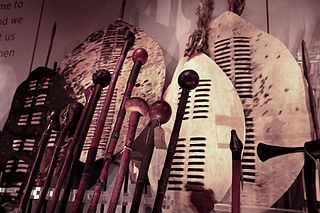

The Basotho blanket is a distinctive form of woollen blanket commonly worn by Sotho people in Lesotho and South Africa. [1]


The Basotho blanket is a distinctive form of woollen blanket commonly worn by Sotho people in Lesotho and South Africa. [1]
Originally gifted to the then ruler King Moshoeshoe I by a British man known only as "Mr Howell" in the late 19th century, [2] these blankets quickly gained popularity in the Lesotho region.
The way that Basotho men wear these traditional blankets is based on the traditional Kaross, an animal skin cloak although their transformation to "factory-woven textile" is attributed to King Moshoeshoe I. [3] By 1860 securing sufficient skins for Karosses was increasingly difficult and by 1872 a large majority of sheepskin covers had been replaced by poor quality cotton or wool. [1] The King secured the production of "special blankets" in 1876 after meeting with Scottish textile manufacturer Donald Fraser. These new blankets were not only sturdier but they could also be fashioned in a way that more resembled the Kaross and they therefore quickly replaced the poor quality imported cloth that the people of Lesotho were previously wearing.
Across the kingdom, a variety of these blankets are worn by the people of Lesotho to represent the different rites of passage in society.
The Moholobela is a fertility blanket worn by young Sotho men in preparation of their transition to manhood. After the initiation ceremony, the young men in Lesotho will don a different blanket known as the Lekhokolo, which confirms that they have reached adulthood.
It used to be the case that a Mosotho bride would wear a Motlotlehi blanket on their wedding day, but the Lingoetsi blanket has since replaced its obsolete counterpart. [4] Husbands, on the other hand, traditionally gift their wife a Serope blanket when their first child is born. [5]
Seana Marena: [6] Means chief's blanket or to swear by the king: This particular blanket is exclusively worn by the king and his chiefs, it has the highest status of all Basotho blankets.
Lehlosi: [7] A Chiefly blanket made of patterns from the skin of wild cat or leopards. At present, one will often observe chiefs wearing commercially manufactured blankets bearing the print of a leopard, rather than actual leopard skins.
Victorian/ Malakabane: [7] According to a local legend, in 1897 Queen Victoria visited the Lesotho (this did not actually occur). She gave King Lerotholi a gift, which happened to be a blanket. He wore the blanket with elegance, in a manner that represented the Poncho, over his shoulders and there the blanket wearing tradition began. The blanket was named Victoria England. The Sotho people had a great love and respect for Queen Victoria and the Victoria England blanket has become a sought after status symbol.
Motlatsi: [7] designed and produced to pay tribute to the birth of Prince Lerotholi. Motlatsi means "successor".
Letlama: [8] worn by traditionally initiated men & women " tlama" is to tie "ke e tlametse mathata aseng basali ba batho" ("I have tied it(the blanket) for my own problems not for other men's wives') is what one who wears this particular blanket would say.
Lingoetsi: [9] a bride's blanket.
Batho Ba Roma: [8] remembering Pope John Paul's visit to Lesotho in 1988.
Kharetsa: [8] named after the aloe which is indigenous to the Maloti Mountains of Lesotho.
Sefate and Morena: [8] are used by the Basotho people as an everyday wearing blanket.
Ketelo ea Morena Papa which means the visit of the Pope: [10] Pope John Paul II once had a visit to Lesotho in 1988, a blanket gift was given to him which has been placed in the Vatican in Rome. [6]
Louis Vuitton's designs for the 2017 menswear collection featured designs from Basotho Blankets which caused controversy in South Africa with accusations of cultural appropriation. [11] Fashion designer Thabo Makhetha-Kwinana is known for her Basotho blankets designs.[ citation needed ]
In the 2018 films Black Panther and in Avengers: Infinity War , W'Kabi and his tribesmen appear in many scenes wearing what looks like the Basotho blanket. Given that the actors in the film were not from Continental Africa, several continental African groups viewed the appropriation of these cultural symbols as inappropriate for use by diasporic Africans. [12] The movie however brought the blankets to international attention and brought about an increase in sales. [13]

Lesotho, formally the Kingdom of Lesotho, is a landlocked country in Southern Africa. As an enclave of South Africa, with which it shares a 1,106 km border, it is the only sovereign enclave in the world outside of the Italian Peninsula. It is situated in the Maloti Mountains and contains the highest peak in Southern Africa. It has an area of over 30,000 km2 (11,600 sq mi) and has a population of about 2 million. Its capital and largest city is Maseru.

The history of people living in the area now known as Lesotho goes back as many as 400 years. Present Lesotho emerged as a single polity under King Moshoeshoe I in 1822. Under Moshoeshoe I, Basotho joined other clans in their struggle against the Lifaqane associated with famine and the reign of Shaka Zulu from 1818 to 1828.

Maseru is the capital and largest city of Lesotho. It is also the capital of the Maseru District. Located on the Caledon River, Maseru lies directly on the Lesotho–South Africa border. Maseru had a population of 330,760 in the 2016 census. The city was established as a police camp and assigned as the capital after the country became a British protectorate in 1869. When the country achieved independence in 1966, Maseru retained its status as capital. The name of the city is a Sesotho word meaning "red sandstones".

Basutoland was a British Crown colony that existed from 1884 to 1966 in present-day Lesotho, bordered with the Cape Colony, Natal Colony and Orange River Colony until 1910 and completely surrounded by South Africa from 1910. Though the Basotho and their territory had been under British control starting in 1868, the Cape Colony was unpopular and unable to control the territory. As a result, Basutoland was brought under direct authority of Queen Victoria, via the High Commissioner, and run by an Executive Council presided over by a series of British Resident Commissioners.
The term Batlôkwa refers to several Kgatla communities that reside in Lesotho and South Africa.

The Sotho, also known as the Basotho, are a prominent Sotho-Tswana ethnic group with roots in Southern Africa. They primarily inhabit the regions of Lesotho and South Africa.

Moshoeshoe I was the first king of Lesotho. He was the first son of Mokhachane, a minor chief of the Bamokoteli lineage, a branch of the Koena (crocodile) clan. In his youth, he helped his father gain power over some other smaller clans. At the age of 34 Moshoeshoe formed his own clan and became a chief. He and his followers settled at the Butha-Buthe Mountain. He became the first and longest-serving King of Lesotho in 1822.

The Free State–Basotho Wars refers to a series of wars fought between King Moshoeshoe I, the ruler of the Basotho Kingdom, and white settlers, in what is now known as the Free State. These can be divided into the Senekal's War of 1858, the Seqiti War in 1865−1866 and the Third Basotho War in 1867−68.

A knobkerrie, also spelled knobkerry, knobkierie, and knopkierie (Afrikaans), is a form of wooden club, used mainly in Southern Africa and Eastern Africa. Typically they have a large knob at one end and can be used for throwing at animals in hunting or for clubbing an enemy's head. For the various peoples who use them, they often have marked cultural significance. Being able to carry the knobkerrie has also had a political dimension, especially in South Africa.
A kaross is a cloak made of sheepskin, or the hide of other animals, with the hair left on. It is properly confined to the coat of skin without sleeves and used to be worn by the Khoikhoi and Bushmen / San peoples of South Africa. These karosses became replaced by a blanket. Their chiefs wore karosses of the skin of the wild cat, leopard or caracal. The word is also loosely applied to the cloaks of leopard-skin worn by the chiefs and principal men of several southern African tribes. Kaross is probably either a genuine Khoikhoi word, or else an adaptation of the Dutch kuras, a cuirass. In a vocabulary dated 1673 "karos" is described as a "corrupt Dutch word."

The Sotho-Tswana, also known as the Sotho or Basotho, although the term is now closely associated with the Southern Sotho peoples are a meta-ethnicity of Southern Africa. They are a large and diverse group of people who speak Sotho-Tswana languages. The group is predominantly found in Botswana, Lesotho, South Africa, and the western part of Zambia. Smaller groups can also be found in Namibia and Zimbabwe.
'Mantšebo was the ruler of Basutoland from 1941 to 1960, as the regent for her stepson, the future Moshoeshoe II.

Christianity is the dominant religion in Lesotho, with Protestantism and Catholicism being its main denominations.
Modderpoort, also known as Lekhalong la Bo Tau or ‘The Pass of the Lions’, is the site in the eastern Free State, South Africa, where the Anglican Missionary Brotherhood, the Brotherhood of St Augustine of Hippo, was established by Bishop Edward Twells in the late 1860s. It is also associated with the BaSotho prophet ‘Mantsopa, while the ‘sacred landscape’ in the vicinity includes San rock painting sites.

Shweshwe is a printed dyed cotton fabric widely used for traditional Southern African clothing. Originally dyed indigo, the fabric is manufactured in a variety of colours and printing designs characterised by intricate geometric patterns. Due to its popularity, shweshwe has been described as the denim, or tartan, of South Africa.

A mokorotlo is a type of straw hat widely used for traditional Sotho clothing, and is the national symbol of Lesotho and the national symbol of the Basotho and Lesotho peoples. An image of the Mokorotlo appears on the Lesotho flag, and on Lesotho vehicle license plates. The design is believed to have been inspired by the conical mountain Mount Qiloane. It is known as “molianyeoe”, which means "he who executes judgement in court" in Sesotho. It is manufactured from an indigenous grass known as “mosea” or “leholi”.
Lebollo la basadi also known as female initiation among the Basotho is a rite of passage ritual which marks the transition of girls into womanhood. This activity is still practiced in the Free State, Mpumalanga, Eastern Cape and KwaZulu Natal provinces of South Africa. In Sesotho, lebollo means initiation. The Basotho rite of passage ritual, unlike other practices in Africa, does not involve procedures which remove parts of the female genital organ. However, the inner folds of the labia are enlarged & elongated by stretching for a more pleasurable sexual experience. In areas where initiation is still valued, uninitiated girls are ridiculed by society.
Sesotho poetry is a form of artistic expression using the written and spoken word practiced by the Basotho people in Southern Africa. Written poetry in the Sesotho language has existed for over 150 years however, the oral poetry has been practiced throughout Basotho history.

'Mantsopa Anna Makhetha (1793–1908), often referred to as 'Mantsopa, was a Basotho prophetess, rainmaker, and storyteller. She advised King Moshoeshoe I and predicted the outcomes of several battles, including the Battle of Viervoet in 1851 and the Battle of Berea in 1852. She was exiled to Modderpoort in the late 1860s, where she converted to Christianity and was baptised in 1870. She fused Christianity with her own traditional Basotho customs.
Thabo Makhetha-Kwinana is a fashion designer known for her designs which fuse African and Western styles, with a focus on Basotho culture